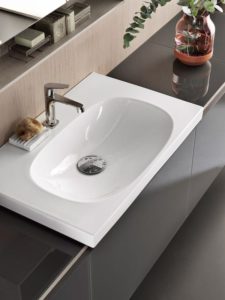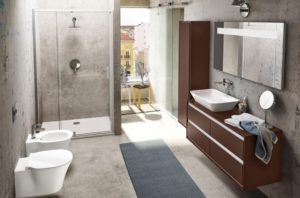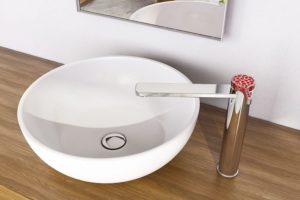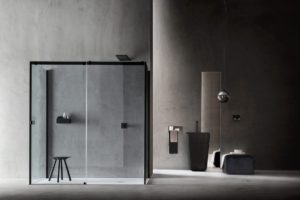Products Trends


The sustainable lightness of wellness | by Luisa Pianzola
The bathroom is currently the most exciting domestic space in terms of aesthetic and technological research. Perhaps it’s the combination of physicality (the human body, water) and emotion (contact with one’s most authentic self), of archaism (nature, purity and simplicity) and futurism (home automation, advanced functions). But the fact is that the room devoted to wellness is a constantly-evolving melting pot of ideas whose goal is to redesign the space in keeping with a total bath concept that leaves nothing to chance while creating consistent and appealing ambiences, magical moments of a private domestic cult (while not forgetting that wellness is a pleasure that should be shared). One of the emerging future-oriented trends is that of eco-sustainability, an area that has long been of interest to companies and designers but is now seeing particularly vibrant growth. The new space devoted to care for the body is becoming increasingly digital, responsible and sustainable, and is attracting numerous innovations spanning ethics, relaxation, design and technology.
An increasingly green-oriented comfort zone
It all started a few decades ago when companies began introducing more environment- and consumer-friendly production processes, leading to the development of recyclable materials and energy-saving furnishing solutions. Today’s research efforts are focused on solutions such as antibacterial surfaces which ensure a high level of sanitisation and non-toxicity and allow for the use of smaller quantities of detergents in cleaning operations. Further important developments include the introduction of procedures and functions such as galvanic coatings for taps and digital programming to reduce the energy consumed by electric towel rails. WCs are also becoming increasingly effective at reducing water consumption, with almost all companies able to install 4.5 litre flush models. Considering that most toilets currently function with flush volumes of around 9-12 litres, it is easy to imagine the enormous scale of this innovation. As for lower production costs, one process that is becoming increasingly popular in the tap sector is that of additive manufacturing, i.e. 3D printing of objects in the desired shape and materials.
Investing in research: essential for everyone
Given the urgency of today’s ecological problems, all companies are looking seriously at how they can reduce their environmental impact. This is a perfectly feasible goal as the necessary technologies are already in place. The sector’s businesses are investing strongly in innovation, with both large brands and small and medium-sized companies devoting a sizeable percentage of their turnovers to research.
Care for the environment equates with comfort and safety
The bathroom – and the shower area in particular – are the domestic spaces where we are most alone and vulnerable, so it is vital that they be as safe as possible. With this in mind, we are seeing increasing numbers of shower trays that combine plantar comfort with non-slip properties. Attention to corporeity (and to needs deriving from permanent or temporary disabilities) is another of today’s trends in wellness spaces, aided by the pervasive but invisible presence of technology and the development of ever more meticulously designed furnishing systems.
A holistic dimension
To conclude, today’s bathroom spaces are focusing not just on functional performance but also on their emotional and multisensorial components. Increasingly seen as the place for restoring a sense of harmony between body, mind and spirit, the bathroom represents the evolution of the spa concept in which materials, colours and technologies are designed to promote physical and psychophysical regeneration in a seductive context where lines and volumes are increasingly subtle, light, compact and versatile.
May 2018
- 01. The Acanto collection from Pozzi-Ginori is a complete system of washbasins, WCs, bidets, furniture and accessories. The washbasins feature an innovative wall mounting system that makes them quick and easy to install.
- 02. Ideal Standard presents the Connect Air system of bathroom furnishings, WCs and washbasins. The WCs feature a quick-release slow-close seat, universal flush for installation without building work, and rimless AquaBlade technology for superior aesthetics and ease of cleaning.
- 03. The additive manufacturing (3D printing) method is used to produce the One Series tap collection from Webert. In particular, the Coral line designed by BMB Progetti has a lever inspired by organic underwater shapes.
- 04. The Flow series wall-hung rimless WCs designed by Terry Pecora for Simas come in linear and compact volumes, square, oval, rectangular and round shapes and a range of sizes.
- 05. Entirely Italian-made and available in sliding and swing door versions, the Otto frameless shower enclosure from Arblu stands out for its attention to detail, its rigorous and essential profiles and its high-quality finishings.
- 06. The Goclean® system installed on the Flaminia WC coupled with the round and perfectly smooth surfaces makes it quick and easy to clean.
The Spring/Summer 2018 collection of Italian sanitaryware can be seen at >> Products&Trends Gallery <<










